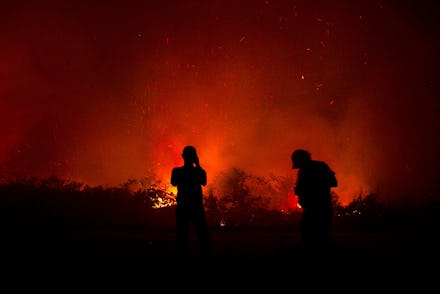Forest fires are turning Indonesia's skies blood red. Here's what you should know

The skies are an eerie blood red in Indonesia. Those in the area, including reporters and office workers, need only look out the window to see an ominous crimson cloud and skies full of smoke. There's an endless haze that seems to stretch to infinity, and it's all due to dozens of forest fires throughout Indonesia as well as Malaysia. A terrifying red cast that looks like something out of a disastrous sci-fi film is causing eyes and throats to ache and breathing issues for residents. It's also resulting in footage that looks positively otherworldly.
These are just some of the recent developments surrounding the widespread forest fires that continue to plague large stretches of land throughout the country. They're affecting air quality for the humans and animals trying to eke out a normal existence, and the smoke from said fires has now even reached the Philippines, about 1,086 miles away from where the fire originated. As the days go by, the fires are getting progressively worse, spreading further, and there doesn't appear to be an end in sight.
How did these fires begin? Similar to the genesis of the devastating Amazon wildfires that tore through Brazil's rainforest, it's believed that the fires are the result of human actions, not natural phenomena. Farmers are utilizing destructive methods to clear out forest areas throughout Borneo and Sumatra in a bid to open up new space for land that can be used to grow new crops – namely for new areas to cultivate palm oil.
These actions are collectively referred to as the "slash-and-burn" method, in which forested land is cut down and remaining vegetation burned to the ground. The layers of ash will provide nutrients for additional crops to flourish, and that's supposed to make it simpler to grow new vegetation in the shadow of the old.
But despite its supposed efficacy, there are still a host of issues that come along from using this method to grow crops, according to the EcoLogic Development Fund. Deforestation is an obvious issue, as is the loss of habitats for species and the release of carbon into the atmosphere that eventually contributes to the larger picture of global climate change and more accidental fires. What was once a viable method of growing crops for thousands of years in Central America and Mexico has grown into a largely unsustainable act that causes more problems than it solves.
And it isn't just people who are affected, obviously. Various types of wildlife are being displaced as the fires roar through and the haze thickens. In fact, Bornean orangutans, an already endangered species, are right in the crosshairs. The Telegraph reports that the Borneo Orangutan Survival Foundation currently has 37 younger orangutans affected by the fires' air pollution in their care.
The primates are thought to have contracted "mild respiratory infections," and need time to recover – but when this species is already threatened to the point of extinction, additional care must be taken to preserve their lives as swiftly as possible. This can obviously be difficult to do when the fires are not only polluting the air they breathe, but they're destroying the orangutans' habitats. There are only about 104,700 Bornean orangutans remaining in the world, according to the World Wildlife Fund's statistics, which is a critically low number.
This year alone, Indonesia's raging fires have already claimed around 340,000 hectares of land (one hectare is about the size of a football field or similar sports stadium). The Indonesian government has been doggedly attempting to find the responsible parties for these fires, to protect the wildlife and human beings caught in the crossfire, but it's all been to no avail thus far.
The government's push to hold parties responsible may be at odds with its goals to keep the country's palm oil industry safe from potential scrutiny, though. Indonesia accounts for 54 percent of the world's crude palm oil production and in August, the government banned products that were labeled free of palm oil from stores. Indonesia's president has even stated that all diesel fuel in the country should be replaced with 100 percent palm oil going forward, Vice reports. The government may be facing some hard choices as it weighs environmental concerns against those of the palm industry as the fires burn on.
In terms of what will eventually work to bring this massive devastation to an end, it may very well fall on the people (and everyone else around the world) to raise awareness and work on finding a solution together. Something will have to be done soon enough, at any rate, because the fires are still raging on, and they're affecting more than just the citizens of Indonesia and Malaysia.